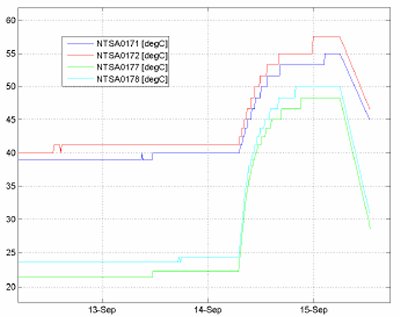No. 65 - Thermal Characterisation
In preparation for the Deep Space Manoeuvre planned on 29 September, the on-board RCS control tables were updated on 6 September to take into account the latest spacecraft inertial characteristics, and the IMP configuration was changed on 13 September from one to two active gyro packages.
A thermal characterisation was performed on the night between 14 and 15 September. The characterised attitude was the same as for the thermal characterisation performed on 31 August 2006, but the overall duration was increased from 12 to 24 hours so that all monitored temperatures could reach steady state. All units reached steady state well within their defined temperature limits.
SREM was kept continuously active in the background for the entire reporting period. All other instruments remained OFF.
A total of 5 New Norcia passes of 4 to 9 hours commanding were taken during the reporting period. In addition, 8 tracking passes of 4 hours have been taken with DSN.
| NNO Pass |
Date | DOY |
Main Activity |
| 919 | 04.09.06 | 247 | Tracking pass |
| 921 | 06.09.06 | 249 | Monitor pass - WOL - RCS Tables Update |
| 926 | 11.09.06 | 254 | Tracking pass - Downlink Noise Test |
| 928 | 13.09.06 | 256 | Monitor pass – WOL - IMP reconfiguration for DSM2 |
| 929 | 14.09.06 | 257 | Thermal Characterisation (SAA 110° at 1AU) |
At the end of the reporting period (DOY 258) Rosetta was at 284.0 million km from Earth (1.90 AU; one-way signal travel time was 15 minutes 11 seconds). The distance to the Sun was 151.4 million km (1.01 AU).
Spacecraft Status
Thermal
The thermal behaviour of the spacecraft is nominal and stable. It remains configured for Active Near Sun cruise (ACM1 since DOY 207/2006). On DOY 249, the TCT lines which had been spuriously declared failed on DOY 243/244 during the first thermal characterisation were manually reset to Prime software control.
A thermal characterisation was performed on DOY257/258 to confirm that the spacecraft can sustain thermally an attitude corresponding to a solar aspect angle (angle between the +Z spacecraft axis and the Sun direction) of 110° at Sun distances down to 1 AU. This attitude had been characterised successfully on DOY 243/244, but only for a duration of 12 hours, insufficient to observe the temperatures reaching steady state.
This time, the spacecraft remained in the characterisation's attitude for 24 hours. The monitored units included the front and bottom thrusters, the RCS lines and the NTO tank temperatures. All units showed a clear temperature increase, but remained within the defined limits and almost reached steady state during the test. The maximum temperature was reached by thrusters 4 and 5 (bottom front attitude thrusters), which reported 57.5 °C during the test. This is within the hard limit of 60 °C defined for these thrusters. The temperature of bottom thrusters 10 and 11 reached about 50 °C, leading to an expected spurious triggering of the on-board Thermal Control Application Program. The below graph illustrates the evolution of the temperature of thrusters 4, 5, 10 and 11 during the test.
 |
|
Evolution of thrusters 4, 5, 10 and 11 temperatures during Thermal Characterisation |
The on-board Thermal Monitoring Application Program reported an out-of-limit on the -X SAS temperature during the test. No action was taken by the on-board software, and the actual unit temperatures were well within their RSDB-defined limits.
The instruments temperatures as reported by the TRPs decreased during the test. The test attitude was such that the HGA shaded partially the +X face of the spacecraft (angle between the +X spacecraft axis and the Earth direction of -40 °C). As a result, the temperature of the two MGAs, as well as of thrusters 2 and 7 (upper front attitude thrusters) decreased significantly during the test.
The conclusion of the test is that it is allowed to keep the spacecraft for one day in an attitude corresponding to a Solar Aspect Angle of 110° at 1AU. For periods longer than one day and Sun distance close to 1 AU, it is expected that the front thrusters will reach their hard upper limit of 60 °C.
Throughout the reporting period, the temperature and pressure of the MMH and NTO tanks were closely monitored to ensure that they remain close to each other for the upcoming Deep Space Manoeuvre. At the end of the reporting period, the pressures of these tanks were within 0.25 bar from each other.
Ground Stations
A total of 5 New Norcia passes of 4 to 9 hours were taken over the reporting period. The station performed nominally during the reporting period, except on DOY 257, when the New Norcia track unexpectedly stopped in the middle of a pass. It was restarted within a few minutes, but about 5 minutes of telemetry were lost at the control centre.
Future Milestones
The Mars Swingby Phase formally started on 28 July. The phase includes the first payload Active Checkout (PC4) in November/December 2006, while the actual swingby will take place on 25 February 2007, followed by a Deep Space Manoeuvre in April 2007.
The next major activity is a Deep Space Manoeuvre of 32 ms-1 (about 40 minutes burn) to be executed on 29 September.
